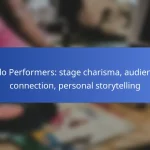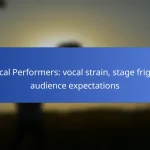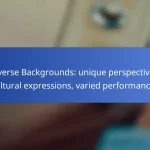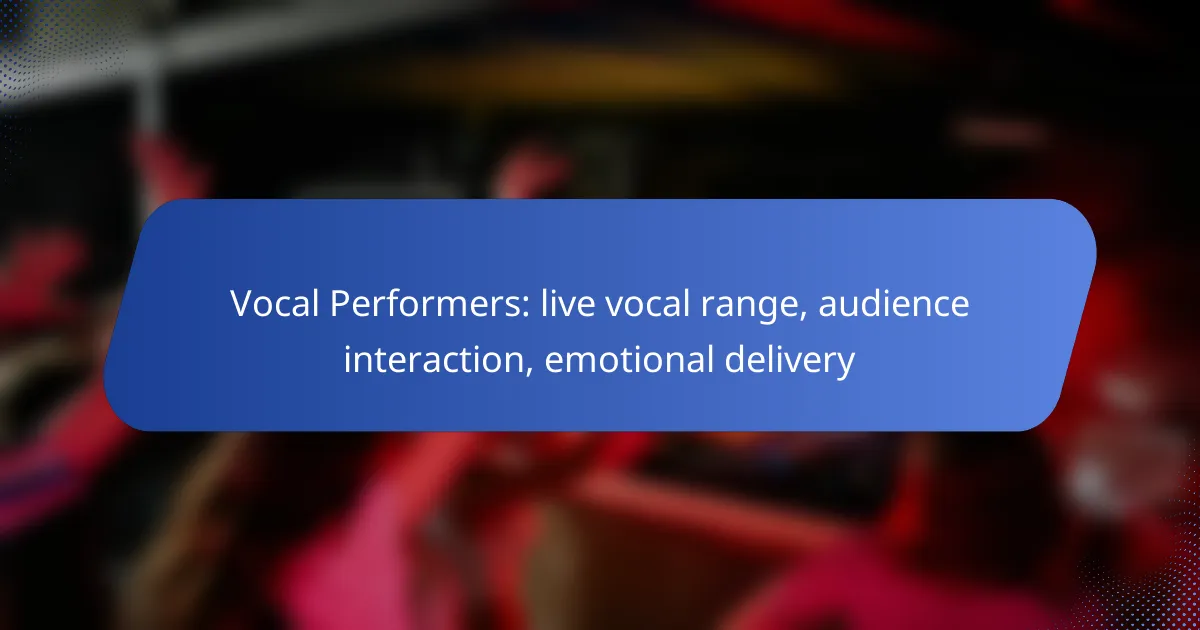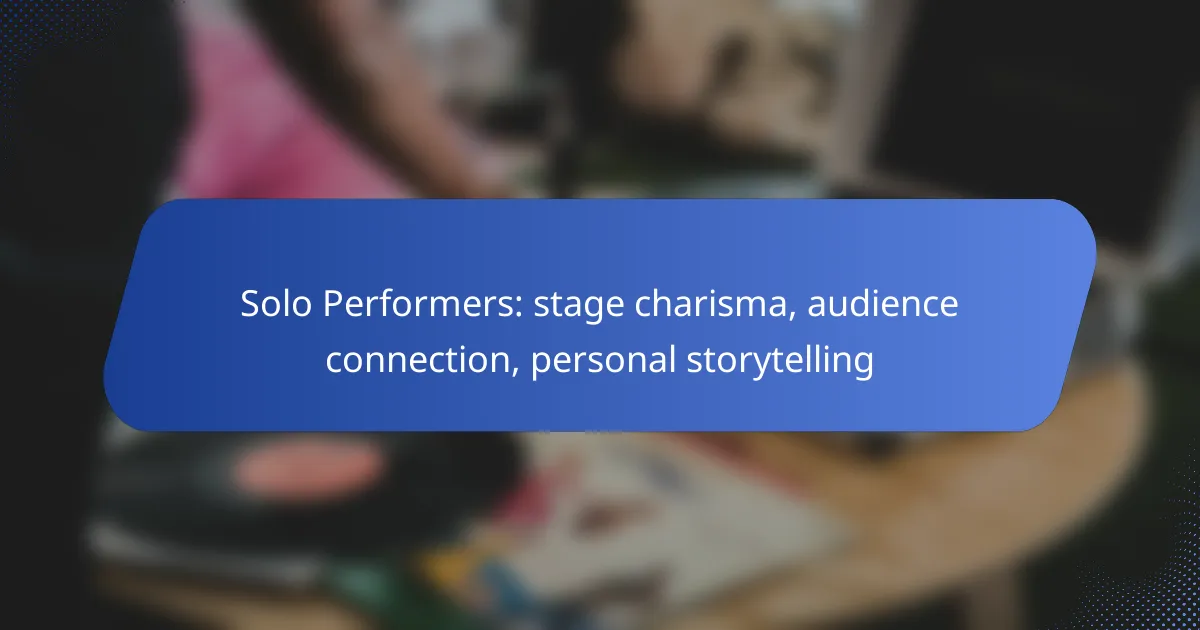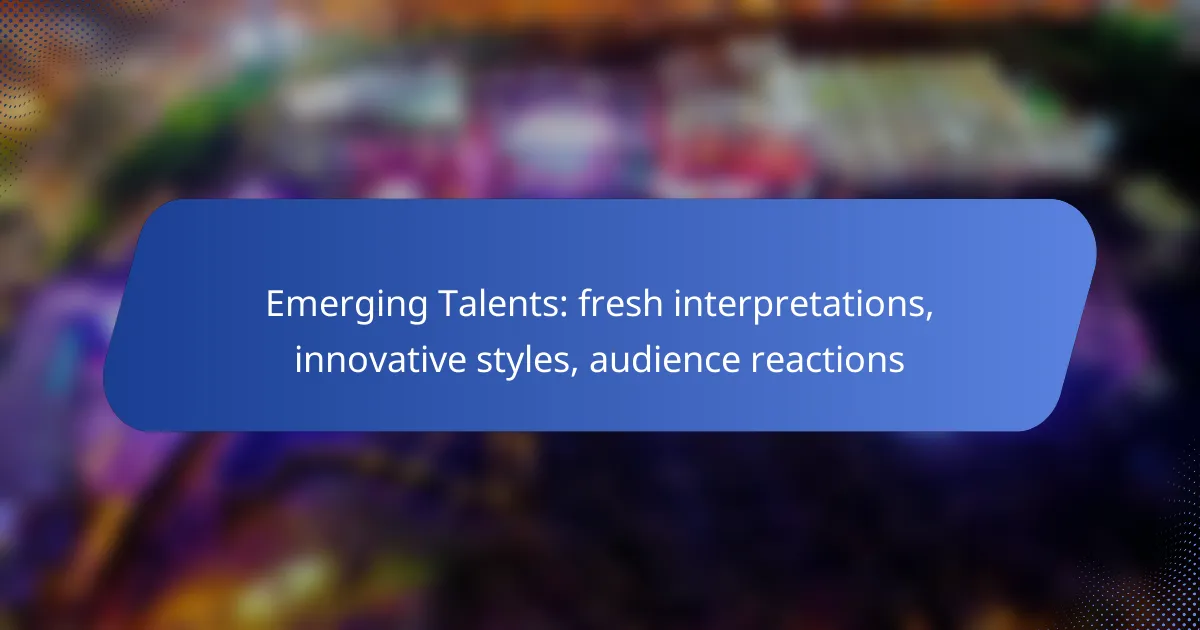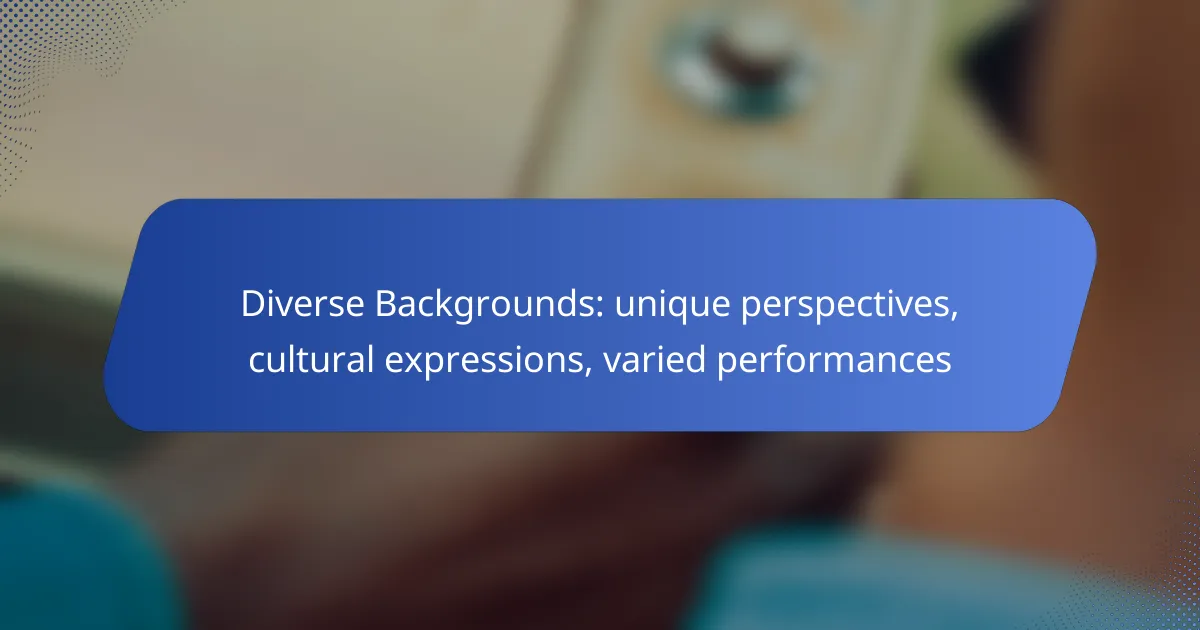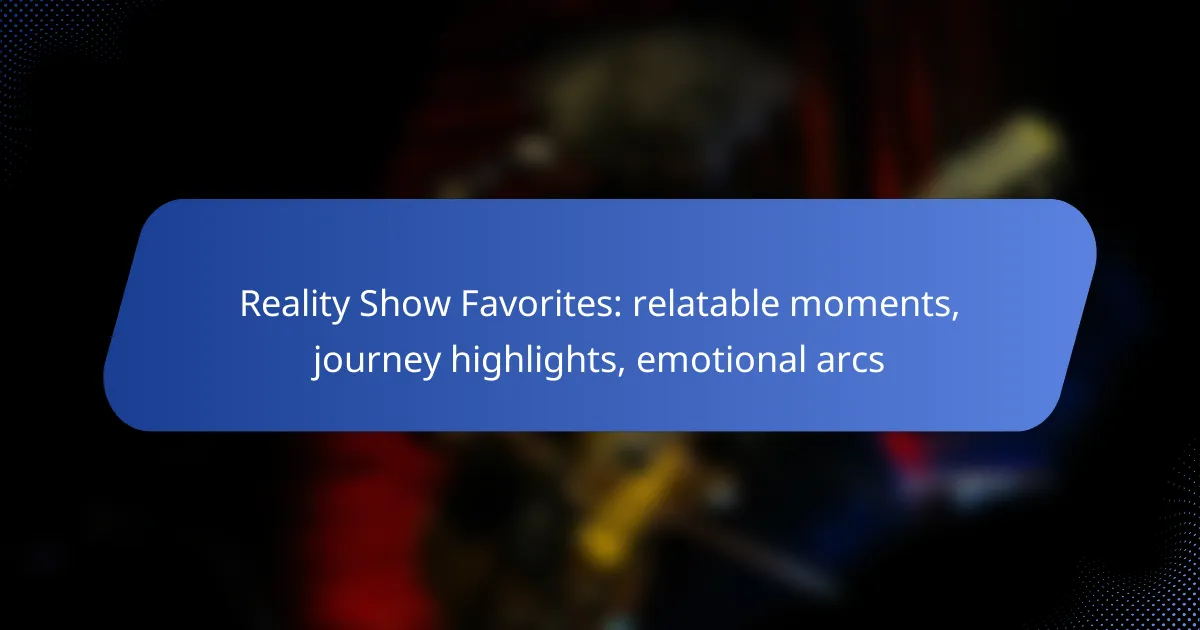Vocal performers can captivate audiences by mastering their live vocal range, engaging in meaningful interactions, and delivering emotionally charged performances. Through dedicated practice and effective techniques, singers can expand their vocal capabilities while fostering a strong connection with their audience. By incorporating storytelling and audience participation, they create immersive experiences that resonate deeply, making their music more relatable and impactful.

How can vocal performers improve live vocal range?
Vocal performers can enhance their live vocal range through consistent practice, targeted exercises, and proper techniques. By focusing on vocal health and utilizing effective training methods, singers can expand their range and deliver more powerful performances.
Vocal exercises and warm-ups
Incorporating vocal exercises and warm-ups into daily routines is essential for expanding vocal range. Simple exercises like lip trills, sirens, and scales can help to loosen the vocal cords and improve flexibility. Aim for a warm-up duration of 10 to 15 minutes before performances to prepare the voice effectively.
Additionally, consider varying the pitch and dynamics during warm-ups. This variation can help singers explore different parts of their range and build confidence in their vocal abilities.
Breath control techniques
Breath control is crucial for sustaining notes and achieving a wider vocal range. Techniques such as diaphragmatic breathing allow singers to use their breath more efficiently, providing better support for higher notes. Practice inhaling deeply through the nose and exhaling slowly through the mouth to develop this skill.
Another effective method is to engage in exercises that focus on breath management, like singing phrases on a single breath or using a metronome to control the pace of exhalation. This practice can enhance both vocal endurance and range.
Vocal training programs
Structured vocal training programs can significantly aid in improving vocal range. These programs often include a mix of theory and practical exercises tailored to individual needs. Look for programs that emphasize range expansion, breath control, and emotional delivery.
Many online platforms offer courses that cater to various skill levels, from beginners to advanced singers. Consider investing time in these programs to receive guided instruction and feedback.
Use of technology in vocal training
Technology can play a pivotal role in vocal training by providing tools for practice and feedback. Apps designed for vocalists often include pitch detection, vocal exercises, and recording features to track progress. These tools can help singers identify areas for improvement and monitor their vocal range over time.
Additionally, using software that allows for pitch correction can aid in understanding how to reach specific notes accurately. This can be particularly useful for those working on expanding their upper range.
Professional coaching options
Engaging a professional vocal coach can provide personalized guidance and techniques to improve live vocal range. Coaches can assess individual strengths and weaknesses, tailoring their approach to meet specific goals. Look for coaches with experience in live performance and a strong understanding of vocal technique.
Consider scheduling regular sessions, as consistent feedback and practice can lead to significant improvements. Many coaches also offer online sessions, making it easier to find quality instruction regardless of location.
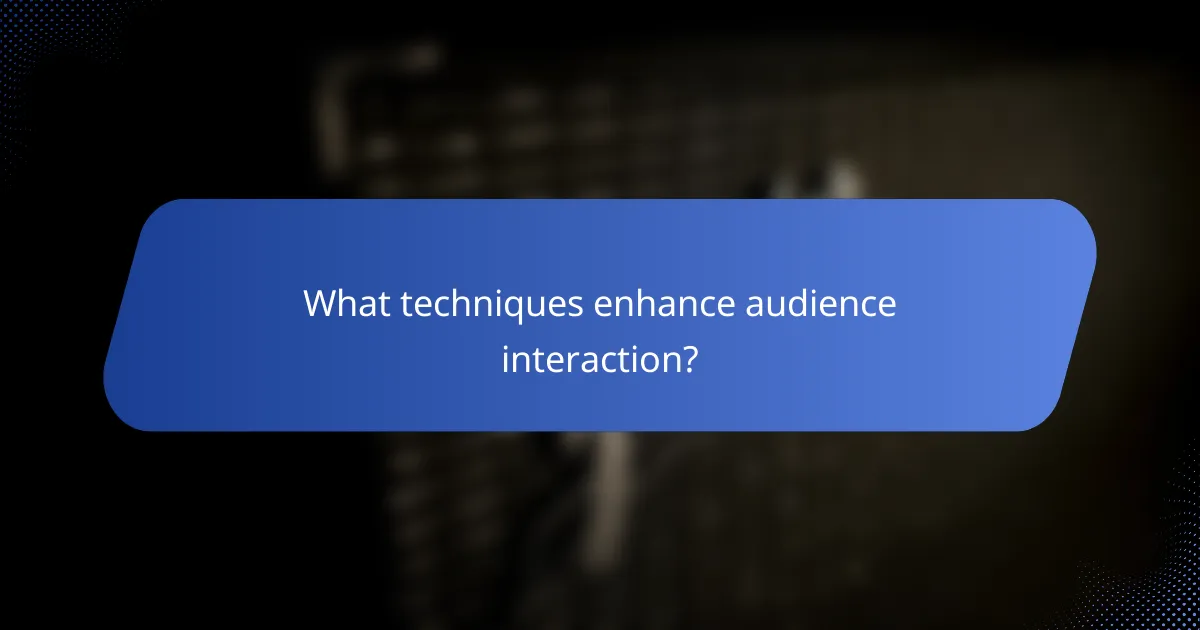
What techniques enhance audience interaction?
Techniques that enhance audience interaction include engaging storytelling, audience participation strategies, effective use of social media, and feedback collection during performances. These methods create a more immersive experience, fostering a connection between the performer and the audience.
Engaging storytelling methods
Storytelling captivates audiences by creating a narrative that resonates emotionally. Performers can weave personal anecdotes or relatable themes into their songs, making the experience more meaningful. For instance, sharing the inspiration behind a song can deepen the audience’s connection to the performance.
Using vivid imagery and descriptive language can help paint a picture in the minds of the audience, enhancing their emotional engagement. Consider incorporating elements of suspense or humor to keep the audience invested in the story being told.
Audience participation strategies
Inviting audience participation can significantly enhance interaction during performances. Simple strategies include call-and-response segments, where the audience is encouraged to sing along or respond to prompts. This not only energizes the crowd but also fosters a sense of community.
Additionally, performers can engage the audience by asking questions or encouraging them to share their experiences related to the song’s themes. This creates a dialogue that makes the performance feel more collaborative and inclusive.
Use of social media for interaction
Social media platforms are powerful tools for enhancing audience interaction before, during, and after performances. Performers can use platforms like Instagram or Twitter to engage with fans, share behind-the-scenes content, or announce live Q&A sessions. This builds anticipation and keeps the audience connected.
During performances, live streaming or posting real-time updates can create a sense of immediacy, allowing those who can’t attend to feel part of the experience. Post-performance, engaging with audience feedback on social media can help strengthen relationships and encourage future attendance.
Feedback collection during performances
Collecting feedback during performances is crucial for understanding audience engagement. Simple methods include using live polls or asking for reactions through hand signals or cheers. This immediate feedback can guide the performer in real-time, adjusting the setlist or delivery to better resonate with the audience.
Another effective approach is to distribute feedback forms or use mobile apps that allow audience members to share their thoughts discreetly. This information can be invaluable for improving future performances and tailoring content to audience preferences.

How does emotional delivery impact performances?
Emotional delivery significantly enhances vocal performances by creating a deeper connection with the audience. When performers convey genuine feelings, it elevates the overall experience, making the music more relatable and impactful.
Understanding emotional connection
Emotional connection refers to the bond formed between the performer and the audience through shared feelings. This connection can transform a standard performance into a memorable experience, as listeners often resonate with the emotions expressed in the music.
Factors such as facial expressions, body language, and vocal nuances contribute to establishing this connection. Performers who are in tune with their emotions can effectively engage the audience, making them feel part of the performance.
Techniques for conveying emotion
To convey emotion effectively, vocal performers can utilize various techniques, including dynamic vocal control, phrasing, and breath support. Varying volume and intensity can help emphasize emotional peaks within a song.
Additionally, storytelling through lyrics and personal anecdotes can enhance emotional delivery. Performers should practice connecting their own experiences to the songs they sing, allowing for a more authentic presentation.
Influence of song choice on delivery
The choice of song plays a crucial role in emotional delivery. Selecting songs that resonate personally with the performer can lead to a more genuine performance, as the artist’s connection to the material will shine through.
Moreover, songs with powerful lyrics and melodies can evoke strong emotions in both the performer and the audience. It’s essential to consider the mood and message of the song to ensure that the emotional delivery aligns with the intended impact.
Case studies of successful emotional performances
Many renowned vocalists have demonstrated the power of emotional delivery in their performances. For instance, Adele’s heartfelt renditions often leave audiences in tears, showcasing her ability to connect deeply through her music.
Another example is Sam Smith, whose performances are characterized by vulnerability and raw emotion, allowing listeners to feel the weight of his lyrics. Analyzing such performances can provide valuable insights into effective emotional delivery techniques.
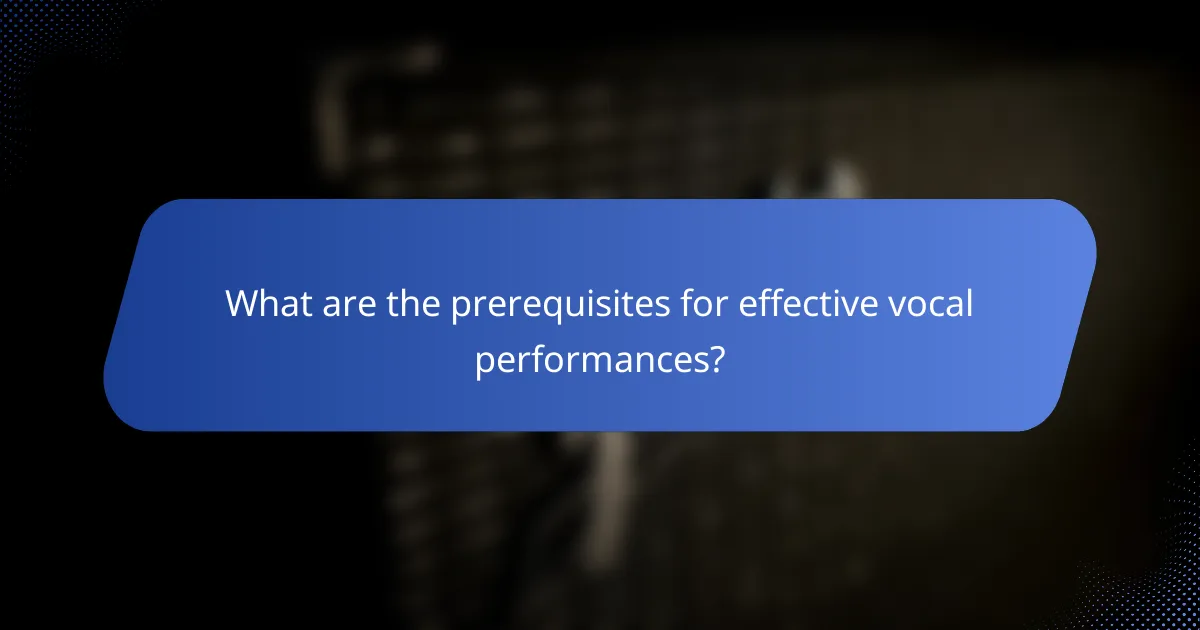
What are the prerequisites for effective vocal performances?
Effective vocal performances require a combination of vocal health, a basic understanding of music theory, and physical fitness. These elements work together to enhance a performer’s vocal range, audience interaction, and emotional delivery.
Vocal health maintenance
Maintaining vocal health is crucial for any performer. This includes staying hydrated, avoiding excessive strain, and practicing proper vocal techniques. Regular warm-ups and cool-downs can help prevent vocal fatigue and injury.
Performers should also be mindful of their environment. Avoiding smoke, extreme temperatures, and allergens can protect the voice. If issues arise, consulting a vocal coach or an ENT specialist can provide tailored advice.
Understanding music theory basics
A foundational knowledge of music theory enhances a performer’s ability to interpret and deliver songs. Understanding scales, chords, and rhythm can improve pitch accuracy and timing. This knowledge also aids in improvisation and audience engagement.
Performers should familiarize themselves with key signatures and song structures. This can help in quickly adapting to different musical styles and collaborating with other musicians effectively.
Physical fitness for performers
Physical fitness plays a significant role in a performer’s stamina and stage presence. Regular cardiovascular exercise can improve lung capacity, while strength training can enhance posture and overall body control. Both contribute to better vocal projection and endurance during performances.
Incorporating flexibility exercises, such as yoga or stretching, can also benefit vocalists. This helps reduce tension in the body, allowing for freer vocal expression and emotional delivery during performances.
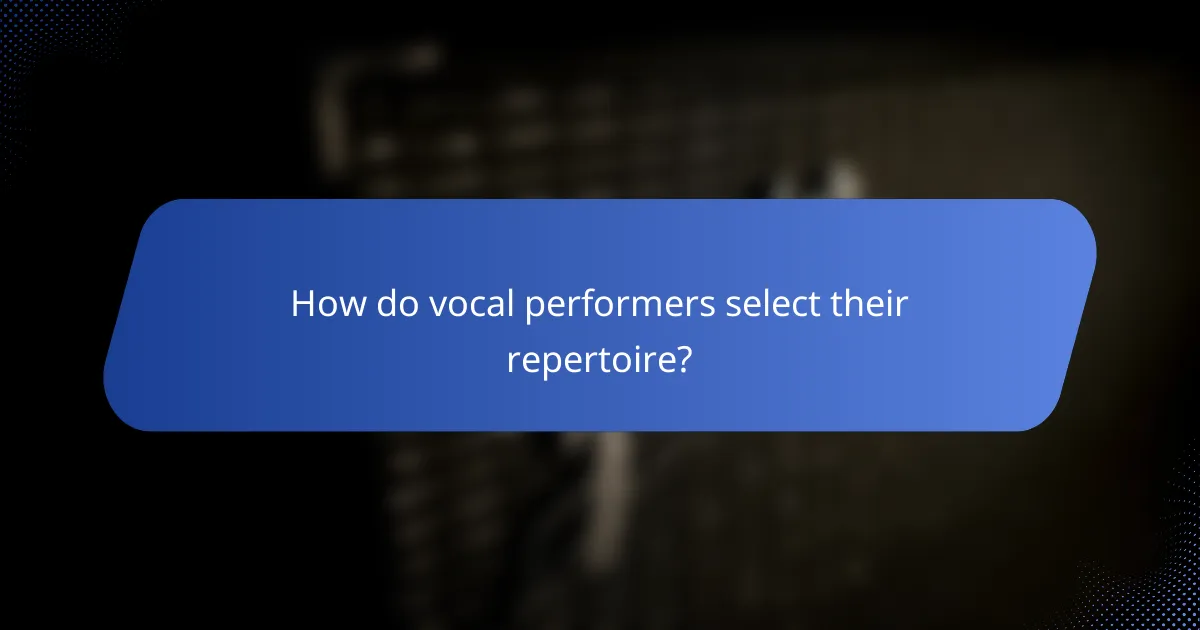
How do vocal performers select their repertoire?
Vocal performers select their repertoire based on various factors including vocal range, audience preferences, and emotional resonance. The choice of songs can significantly impact the overall performance and connection with the audience.
Vocal Range Considerations
Vocal range is a crucial factor in repertoire selection. Performers must choose songs that fit comfortably within their vocal capabilities to ensure a strong and confident delivery. For instance, a tenor might focus on higher-pitched pieces, while a baritone would select songs that highlight their lower range.
Additionally, understanding the range of each piece allows performers to showcase their strengths. It’s often beneficial to experiment with different keys to find the best fit for their voice, which can enhance both performance quality and audience engagement.
Audience Interaction
Engaging the audience is essential for a memorable performance. Vocalists often select songs that resonate with their audience’s tastes and preferences, which can vary by location and event type. For example, a performer at a wedding might choose romantic ballads, while a festival artist might opt for upbeat, popular tracks.
Performers should also consider the dynamics of the event. Songs that encourage audience participation, such as sing-alongs, can create a lively atmosphere and strengthen the connection between the performer and the crowd.
Emotional Delivery
Emotional delivery is key to a powerful performance. Vocalists often select repertoire that allows them to express genuine feelings, which can deeply resonate with the audience. Songs with relatable themes or poignant lyrics can enhance the emotional impact of the performance.
To effectively convey emotions, performers should practice interpreting the lyrics and understanding the story behind each song. This preparation helps them deliver a more authentic and compelling performance, ultimately leaving a lasting impression on their audience.
